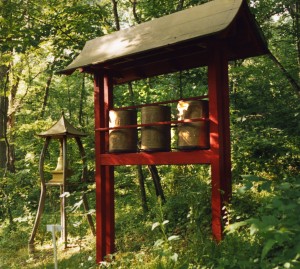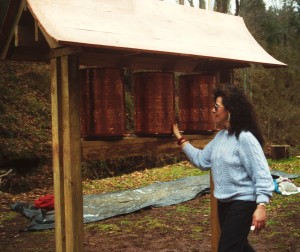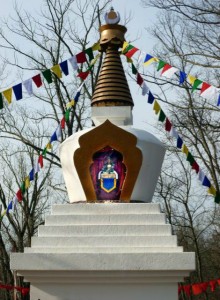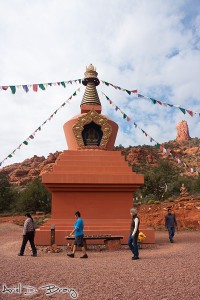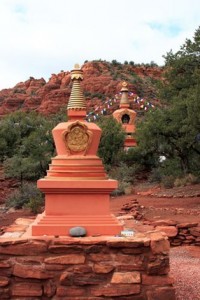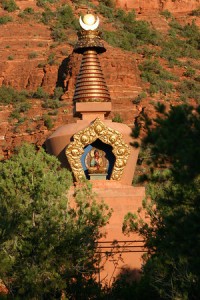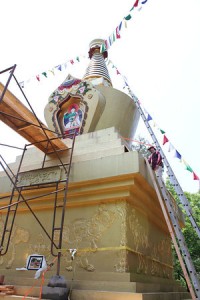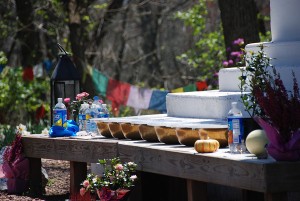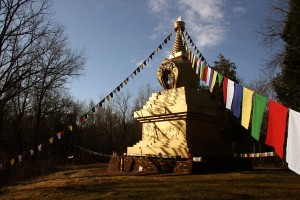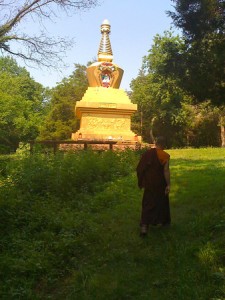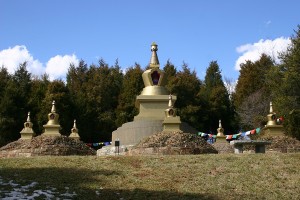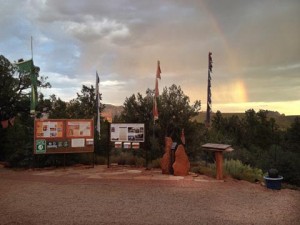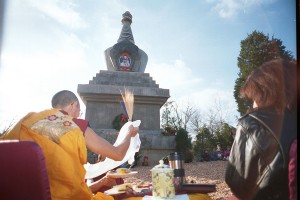
The following is respectfully quoted from “Compassionate Action” by Chatral Rinpoche:
Homage to the Three Jewels!
I will briefly explain the benefits of building a Buddha stupa and the advantages for the faithful ones who prostrate before, make offerings to, and circumambulate it. By establishing here the perfect scriptures as witnesses, may those fortunate ones who can understand this teaching accept it with joy!
In the sutra The way of Distinguishing it is said:
The Buddha told the young Brahmin Naytso,
“There are eighteen benefits of building a Tathagata stupa.
What are those eighteen?
One will be born as the child of a great king.
One will have an excellent body.
One will become very beautiful and attractive.
one will develop a very sharp intellectual capacity.
One will become renowned.
One will have a great entourage of servants.
One will become a leader of people.
One will be a support to others.
[One’s greatness] will be expounded in the ten directions.
One will be able to extensively express whatever one wishes in word and verse.
One will be worshipped by gods.
One will posses many riches.
One will obtain the kingdom of a universal monarch.
One will have a long life.
One’s body will be like a collection of vajras.
One’s body will be endowed with major and minor marks [of a Buddha].
One will take rebirth in the three higher realms.
One will swiftly achieve Nirvana.
These are the eighteen benefits of building a Tathagata stupa.”
In the Manjushri Root Tantra it is said:
If you make a stupa with your own hands,
You will be able to purify your body even if you have committed the five inexpiable sins.”
If you build one hundred thousand stupas,
You will be transformed into a universal monarch of the knowledge-holders.
Completely understand all treatises
And be endowed with skillful means.
FOr the duration of an eon, when you die you will always be reborn as a king and never again go to the lower realms.
Like the sun rising in a central land,
You will be endowed with all your sense faculties.
You will be able to retain all that you learn and remember your past lives.
In the sutra called Chest of Secret Relics it is said:
The Bhagavan proclaimed,
“Vajrapani, when you write down Dharma teachings and place them inside a stupa, that stupa will become a relic of the vajra essence of all Tathagatas.
That stupa will be consecrated by the secret essence of all the mantras of the Tathagatas.
It will become a stupa of ninety-nine Tathagatas, as many as a heap of mustard seeds.
That stupa will be blessed as if it contained the yes and ushnishas of all Tathagatas.
Whoever places images of the Buddha inside a Stupa will definitely be blessed by those Tathagata images with the nature of the seven royal treatises of a universal monarch. Whoever pays reverence and honors that stupa will definitely become a non-returner and will eventually achieve the unexcelled and completely perfect state of enlightenment–actual, full Buddhahood.
Even if one offers only one prostration or makes a single circumambulation, one will be altogether freed from reaching various hell realms such as the Hell of Incessant Torture.
One will never fall back on the path to unexcelled completely perfect Enlightenment.
All Tathagatas will bless the entire area that surrounds the place the stupa has been built in.
In the Sutra of the White Lotus of the Sacred Dharma, it says:
Walls ar emade from mud and bricks
And a stupa of the Victorious One is made likewise.
Therefore, even if made by a simple heap of dust in a remote place of despair, or if a child playing games makes one from a mound of sand,
Whomever simply builds one on the account of the Victorious One
All of them will attain enlightenment.
The benefits of making offerings to a stupa are stated in the Sutra Requested by King Prasenajit:
If one applies whitewash to a Buddha stupa,
One will have a long life in the worlds of gods or humans,
One will be free of mental and physical ailments,
All suffering will be completely removed and
One will always be happy and will become wealthy with worldly riches.
By ringing a bell in front of a Buddha stupa,
One will speak with authority and have great fame,
One will have the pleasant voice of Brahma,
Be able to remember one’s past lives,
And obtain all kinds of adornments.
If a learned person silently recites prayers on their rosary with a faithful mind at a Buddha stupa,
They will have many golden rosaries adorned with beautiful precious jewels,
And will be foremost among the meritorious and fortunate ones.
Whoever makes a melodic music offering at a Buddha stupa
Will have an abundance of courageous eloquence in profundity and knowledge,
Their physical body will be perfect and their mind and speech pure.
Their voices will fill the world.
If any person who has a heart and body,
Hangs various banners from the stupa
Which is a stainless source of merit,
It will become a field of offerings and an object of worship for the three worlds.
If one affixes a silken crown to a Buddha stupa,
One will become a glorious ruler of gods,
Will experience great bliss, and in particular,
Will attain the crown of complete liberation.
If one cleans a Buddha stupa,
One will become very attractive and beautiful to look at,
One will have an excellent face
With the complexion of a lotus,
And one will be completely devoid
of the defects of Samsara.
Whoever cleans off the dust around a stupa
In the springtime with clean water
Will be joyfully fanned by ladies
Holding golden-handled fans.
Regarding the benefits of prostrating and circumambulating a stupa, it is said in the Avalokiteshvara Sutra:
If one respectfully prostrates before a Buddha stupa,
One will become a heroic and powerful world monarch.
Protected by the armor of gold-colored symbols
One will become an authoritative teacher who will delight the Buddhas.
In the Sutra of the White Lotus of the Sacred Dharma it is said:
Whoever joins their palms together before a stupa,
Whether with both hands or just one,
Whoever briefly bows their head
Or bows their body just once,
Whoever prostrates or merely says “Buddha” even with a distracted mind,
Whether once or a few times
Before a stupa where relics are kept,
Will attain supreme Enlightenment.
In the Decisive Verses on Circumambulating a Stupa it is said:
The excellent qualities of circumambulating
A Stupa of the Buddha, Protector of the World,
Cannot be sufficiently described with mere words.
These and other quotations from the sutra and tantra scriptures should produce great joy and confidence. I encourage all those who aspire to happiness to make the most of their human existence. Strive as much as you can to accumulate merit and purify obscurations by paying homage and making offerings, circumambulating, making prayers of aspiration and so on with a noble bodhicitta motivation, to the excellent supreme foundation (stupas), which grant very meaningful benefits through seeing, hearing and remembering them.
This was composed by the renunciant Buddha Vajra, who in this time of the rampant five degenerations gives the appearance of guiding beings through the physical embodiment of the Buddha body, speech and mind.”
Composed in the Male Fire Horse Year of the sixteenth Cycle (1966) in the ninth month on the twenty-second day. May it be auspicious!
